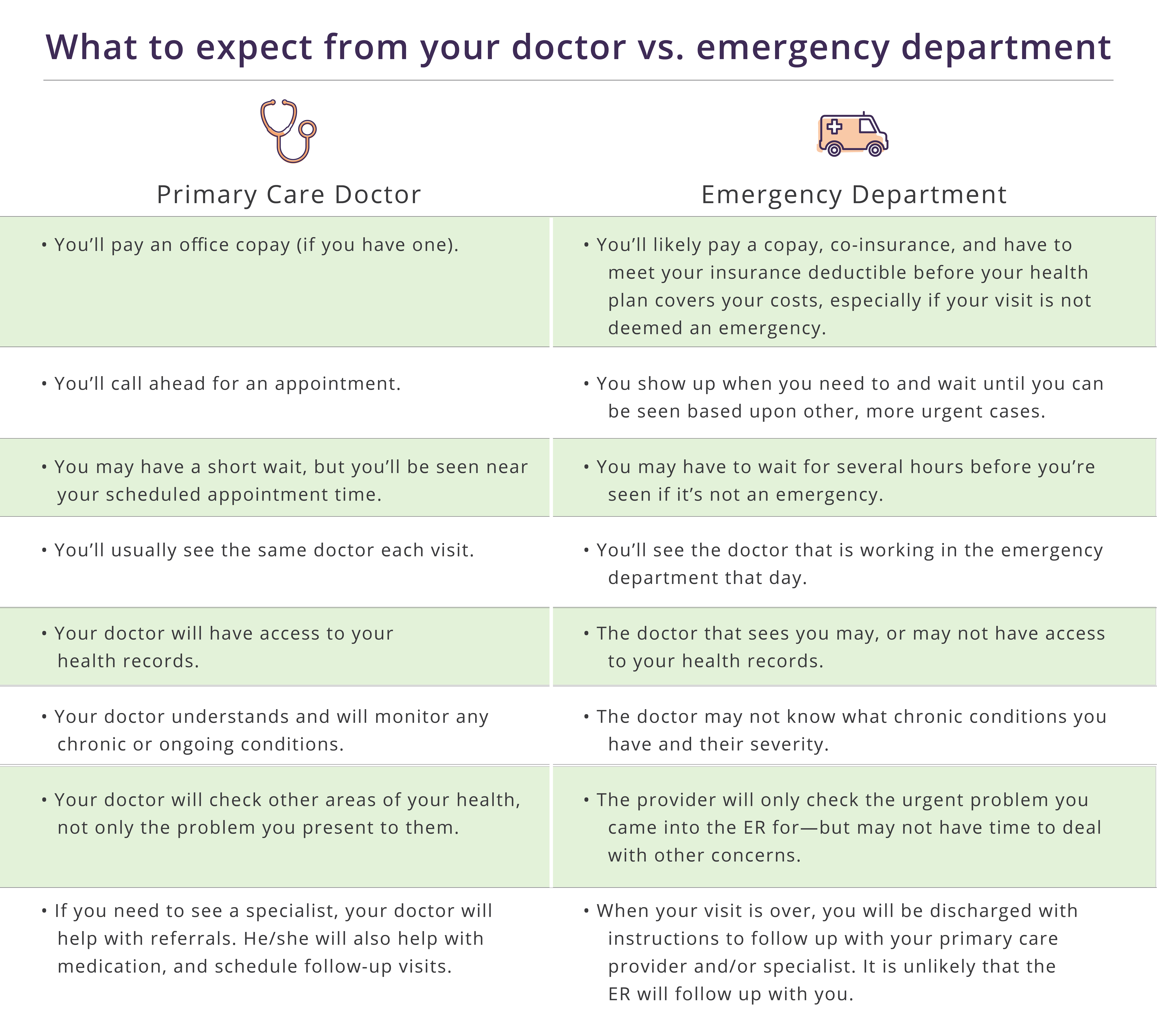
When you need healthcare, your family doctor or pediatrician should be your first call. But when you can't get an appointment quickly, what criteria do you use in making a decision about where to go for care? Deciding if you should go to your own physician, urgent care clinic, or the emergency room can be a challenge. Carrie Lukins, BSN, RN, PHP, Manager of Utilization Review and Case Management, shares information to help you make an educated and confident decision about where to seek care. When an ailment strikes knowing where to go can help relieve some of the worry and stress.
Some life decisions are simple and straightforward, like choosing where to get your vehicle repaired, where to get a haircut, or where to go for lunch. However, when it comes to choosing medical care there are many things to take into consideration such as urgency, affordability, insurance, and convenience.
Four general choices are available for care
There are four general categories available for you to seek care: Your physician’s office, an urgent-care or walk-in clinic, the emergency room, and virtual telehealth visits. This article will discuss and compare the three in-person locations for care. If you would like to learn more about telehealth and virtual health provider visits, please read our blog, Telehealth is more important than ever.
Your physician’s office should be your first choice
Your relationship with your physician is the most important health relationship you have. If you don’t have a primary care physician, consider locating one today. Your physician is the person who understands your health concerns and can make educated recommendations for you. Many physician offices now also offer telemedicine and telehealth for virtual visits that make accessing your primary care doctor more convenient.
Choosing your own physician, and making an appointment, can help you avoid long wait times typically found in an emergency room. Even if your doctor is unavailable or not an expert in the area of care you need, he or she can refer you to a specialist or another medical professional. Oftentimes, this referral can happen more quickly because your physician knows you, has a record of your current health conditions and medications, and is a trusted advisor within the medical community.
When time is most important, go to the emergency room or call 911
If symptoms are critical, and you feel it’s an emergency, act quickly – don’t hesitate. Symptoms that require an ER visit include chest pain, difficulty breathing, unconsciousness, severe headache, severe dizziness, severe vomiting, bleeding that won’t stop, and a broken bone that sticks out of the skin. In some cases, such as a stroke or heart attack, delays in treatment often lead to more serious consequences.
It may seem obvious, but emergency rooms are not the place for routine care. Emergency rooms are designed to treat urgent, acute and life threatening conditions and aren’t the place for routine care or minor ailments. However, every year millions of Americans use the emergency room for routine medical care. They face long waits for care they could receive more quickly in a physician’s office.
What's more, you'll pay far more out-of-pocket costs for emergency room care. Office visit co-payments or co-insurance typically cost less than $50. Emergency room co-payments or co-insurance will cost you significantly more.
If it’s after hours, or on the weekend, go to an urgent care center or walk-in clinic
If you feel your condition doesn’t require the emergency room, or your physician’s office is not available to you, consider an urgent care center or walk-in clinic. Urgent care centers are a good choice when you need care for a minor medical emergency. These centers are accessible and convenient.

To get the most from your urgent care visit, consider preparing by:
1. Check in online if it’s an option
You don’t need an appointment to visit an urgent care center, yet, your wait time can vary considerably depending on the number of people ahead of you. Some urgent care centers allow appointments, so check online or call ahead to see if you can reserve a specific time slot. By checking ahead, you could possibly see a doctor or healthcare provider more quickly after you arrive.
2. Select the right center for your insurance plan
It’s important to choose a center that accepts your health insurance plan (and is in network if applicable) to reduce your out-of-pocket responsibility.
Be aware of the location of the closest urgent care center to your home. Familiarize yourself with the type of services provided by this clinic, as well as the clinic’s operating hours.
3. Know what to bring with you
Urgent care centers don’t maintain an extensive record of a patient’s medical history like a regular doctor’s office. To expedite treatment and receive the best care possible, bring all necessary medical documentation with you to the clinic. This includes your most recent health insurance information and the names of any prescription medications you’re taking. A list of your significant medical diagnoses is helpful too. Also have available your (or your child’s) doctor’s name and office information. If you’re bringing a minor who isn’t your child, make sure you have their parental authorization form.
4. Go during off-hours, if possible
You can visit an urgent care center at any time during the clinic’s normal operating hours. Be aware that specific times of day may be busier than others. This includes nights, weekends, and holidays when many doctor offices are closed.
The more people ahead of you in line, the longer it’ll take to be seen. If you need urgent care but you can wait it out a bit longer, call your nearest urgent care center and ask about the estimated wait time before leaving the house. You’ll be seen by a healthcare provider quicker if you arrive when the clinic isn’t busy.
5. Understand you may not see a doctor
Many urgent care centers have doctors on staff, but they also have a staff of physician assistants and nurse practitioners who can diagnose and prescribe treatment for various health conditions. Regardless of what type of healthcare provider you see, they will likely offer treatment, and then recommend following up with your regular doctor.
6. Don’t go to urgent care for a life-threatening emergency
Urgent care centers are limited in the type of care they can provide. These clinics are suitable when you need treatment for colds, strep throat, urinary tract infections, burns, bug stings, and allergic reactions. Some urgent care clinics can treat small lacerations and fractures.
Keep in mind, visiting an urgent care center when you are experiencing life-threating symptoms is potentially dangerous because doctors at the clinic won’t have the right equipment to treat your problem, and you’ll be sent to the emergency room for treatment.
Know before you go: Assess the care you need
Assess the care you need and associated time and financial costs involved before seeking care. Your own physician should be your first choice, if possible.
If your own doctor is unavailable or care is needed quickly, urgent care centers are convenient and affordable. Understanding what urgent care facilities can and can’t treat can help you decide where to go for the most cost-effective and efficient medical treatment.
And, keep in mind, urgent care centers are not emergency rooms. If you experience a major medical emergency, call an ambulance and get help as soon as possible.



